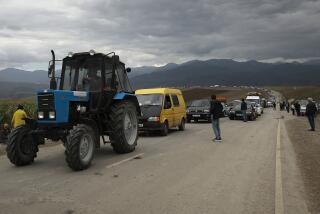For Armenians, a Numbing Normalcy : Earthquake: A year later, 200,000 are still in temporary shelters, and life is grim.
- Share via
KIROVAKAN, Soviet Union — On the dirt roads of this once-bustling city in northern Armenia, ice coats piles of stones still lying where they crashed to the ground in a devastating earthquake, and a cold December rain beats against the walls of the metal shacks that thousands now call home.
But in the Hovanissian household, a metal container without water or heat, there is celebration. A baby has just been born. He is named Aram, after Alah Hovanissian’s last baby, who died in the ruins of the disaster.
“We lost everything we owned, but I live with hope,” said Hovanissian, 31, nursing the infant in the tiny room her family has hung with brightly colored rugs and pictures. “We have a new baby. I believe that someday it will be better than this.”
It has been one year since the powerful Dec. 7 earthquake struck the mountains of this tiny Soviet republic, killing more than 25,000 people and leaving nearly a third of Armenia’s 3.3 million inhabitants homeless.
The horror of corpses among the rubble and of glassy-eyed survivors is long gone. In its place is a numbing sort of normalcy, a sea of gravestones and rows of shelters that resemble metal boxcars in place of what were once ancient towns.
For most survivors of the disaster, life is still grim. Almost none of the villages leveled by the quake have been completely rebuilt. More than 200,000 people are still living in temporary shelters, and reconstruction moves at a snail’s pace.
But on the streets of towns and villages throughout the quake zone, routine has returned. And in the homes of many here, routine brings hope.
“We do live under stress. Day after day, we expect another earthquake to happen,” said Hasmik Badalyan, deputy mayor of Kirovakan, a city of 140,000 where 170 buildings were destroyed in the quake.
“Life, however, is getting more normal: Children are going back to kindergarten. Parents are accompanying them,” he said. “It’s a certain kind of routine, daily life. Young people are going to dances, meeting each other, kissing. There are love stories. Life is back.”
Officials coordinating the international aid effort and local Armenian authorities say their worries are far from over. This autumn the relief effort became intertwined with a political conflict between Armenia and the neighboring Soviet republic of Azerbaijan over the territory of Nagorno-Karabakh.
In a power play unprecedented in Soviet politics, a crippling railroad blockade of Armenia by Azerbaijan prevented supplies from reaching the earthquake zone. Last month, after the Supreme Soviet restored Azerbaijan’s control over the territory, the blockade of Armenia was imposed again.
A week later, long gas lines were common again in Armenia’s capital, Yerevan, and families were buying in quantity, fearing scarcity ahead.
But relief authorities and foreign aid groups say they learned from the last blockade and have stockpiled the materials they need to continue reconstruction. And while foreign aid organizations continue to be frustrated by the slow pace of reconstruction, they say that as of Dec. 1, only a tiny fraction of earthquake survivors were still living in tents.
“Certainly the blockade damaged some of our projects,” said Johannes Richert, head of the International Red Cross delegation in Armenia. “We had no cement, no iron bars, no gravel even. But we have stockpiled our materials, and we are prepared for the blockade this time.
“The situation is better than I hoped for the system here,” Richert added. “Almost everyone has shelter. There’s no lack of food. There are no epidemics. There’s no shortage of clothes or medicine. We are lucky. We are very lucky.”
Luck is relative: In the graveyard in Spitak, where thousands of tombstones are inscribed with the same date of death, women weep pitifully over loved ones.
Near the skeletal ruins of buildings on the plains below the cemetery, people who have not worked in a year live in prefabricated houses. Some sit around in deep lassitude. Cranes and bulldozers stand idle in the ice and muck.
Amid such bleak surroundings, hope is found in small things--in the projects of international aid organizations to build hospitals for the survivors, and in homes of wood for people too traumatized to sleep in stone dwellings again.
Indeed, while the nine foreign aid organizations still working on projects in Armenia say they are frustrated by the slow pace of reconstruction, practically every day a small project is completed by one of the organizations.
On Dec. 1, the United Armenian Fund, a Culver City, Calif.-based coalition of six major Armenian-American groups, delivered $400,000 in goods, including vitamin pills, powdered milk, medical supplies and clothing.
In Kirovakan, there is now a psychological rehabilitation center for children. In Spitak, there is a hospital built and staffed by the Norwegian Red Cross. In Leninakert, a small village about 30 miles from Leninakan, an East German aid group completed 50 chalet-like homes last month.
Around the edges of Leninakan, small villages of homes donated by Austria, Bulgaria, Denmark, Sweden and other countries are nearing completion. And in Yerevan, Red Cross nurses are teaching Armenians how to care for patients with spinal cord injuries.
At the Children’s Psychological Rehabilitation Center, built by the Red Cross in Kirovakan, 2,000 children are treated every day.
Armen Chamurian, 13, was trapped for two hours under the rubble of his school. He managed to escape, only to witness his dead cousin being pulled from the ruins.
“I don’t think I will ever forget the nightmare,” Armen said. “The only place I forget for awhile all that has happened is this center. I go back home, and I can’t sleep. I see it all over again.”
Help also has come from the Soviet government.
In the village of Artik on a snowy afternoon, the Avean family and friends gathered for toasts around a table groaning with food. The family had invited villagers to celebrate the completion of a new, solid-walled home they built for themselves.
“I have built it with my own hands,” said Norik Avean, 42. Since his home crashed to the ground last December, Avean and his family of nine had been living with relatives, where survivors were crowded 12 to a room. But last month Avean laid the last stone of his new home, built with materials paid for by the Soviet government.
As the sun set over Spitak days before the grim anniversary of the quake, Soviet construction teams were busy in the graveyard overlooking the town. They were building a chapel for a ceremony to honor those who died in the powerful temblor.
The graveyard was quiet and empty except for the workers. Today, it will be filled with grieving people. “That will last perhaps a week after the anniversary,” Badalyan, the deputy mayor of Kirovakan, said. “Then spirits will rise again.”
“Hope has never gone from the Armenian people, I think,” said Red Cross worker Encho Gospodinov. “It is human nature, and it is the Armenian soul.”
More to Read
Sign up for Essential California
The most important California stories and recommendations in your inbox every morning.
You may occasionally receive promotional content from the Los Angeles Times.










